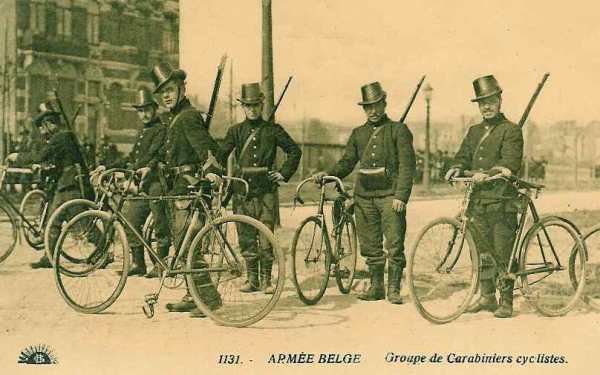Pre-War/Early War III

Chasseurs-à-pied
The uniforms of the Chasseurs-à-pied resembled those of the line infantry but were of different branch colors and included a different field cap. The dress tunic, field jacket, and great coat were to be made from a dark green wool. The tunic featured light green wings and could also feature yellow piping along the facings. In addition to buttons showing the regimental number, the jackets and greatcoats of the light infantry units could be stamped with the infantry horn. This same insignia could also be seen on the collars and the field cap. The trousers were to be made from a “Belgian gray” wool and have yellow piping, though, by 1914, they were seen in different shades of grey and piped in green, yellow, or left unpiped. Instead of the Camembert cap worn by the line infantry in the field, the Chasseurs wore a pointed or cone-shaped Shapki (Chapki or Czapka) cap. It was made from a dark green wool and had a yellow band and yellow piping. The shako had light green trimmings and a yellow pompom and/or black plume. Like every other branch of the infantry, Chasseurs were issued the Mauser M1889 Rifle and M1896 accoutrements, the M1891 gaiters and the M1901 boots.


Carabineers
As the second branch of Light Infantry, Belgian Carabineers wore nearly the same uniform as the Chasseurs-à-pied, except for their service hat, which was a Corsican-type black felt hat called a Chapeau. This hat could include a national cockade on its side as well as a black plume and/or green pompom, but it was often left blank while on service. The Carabinier units wore buttons and insignia with the light infantry horn rather than regimental numbers. Carabineer greatcoats were by regulations supposed to be dark green, but could appear to be black. The trousers were also officially supposed to be a color called 'Marengo-grey' and piped in yellow, but could appear to be a darker grey and even black, and could be piped in green or left unpiped. This seemingly black uniform from head to toe did not go unnoticed. The German's supposedly called the pesky Carabineers 'Black Devils'. They too were issued the accoutrements, rifle, &c. as the infantry. The top photo shows a Carabineer machine-gun team wearing the pointed Shapki field cap of the Belgian Light Infantry units. One resource this branch enjoyed more than the others was the use of small carts or wagons drawn by well-trained dogs. These carts carried equipment, including machine guns, along with the columns of Carabineers. There were also a battalion of military cyclists formed from the ranks of the Carabineers. Apart from their field caps, they were uniformed and equipped along the same line as the other Carabineer units, but with the addition of folding bicycles, a model called the 'Belgica' manufactured by M. Mettewie of Belgium. The cyclists wore a tapered peaked field cap instead of the Chapki. It featured a yellow band and piping and a Carabinier bugle-horn badge.

Grenadiers
The Grenadier uniforms resembled those of the Infantry of the Line, apart from their trousers and their headgear. Grenadier trousers were dark blue with a broad scarlet stripe on the sides. And, instead of Shakos, Grenadiers wore bearskin hats. They also wore grenade insignia on the corners of their collars, and their tunic and greatcoat buttons were imprinted with the flaming bomb symbol rather than a regimental number.

Infantry Officers
For the most part, infantry officers wore the same uniform as the men under their command. There were minor differences, such as the addition of rank stripes on the sleeves of NCOs, or the addition of broader trouser stripes. Badges of rank were worn on the collars of commissioned officers. Officers also wore a low shako, of the French pattern. In full dress order, officers also added sashes, epaulettes and plumes. Infantry swords were still to be carried on service per the regulations of 1914. In addition to their swords, officers were also armed with a pistol, usually the Browning FN M1900, M1903, M1910, or the Colt 1903.

